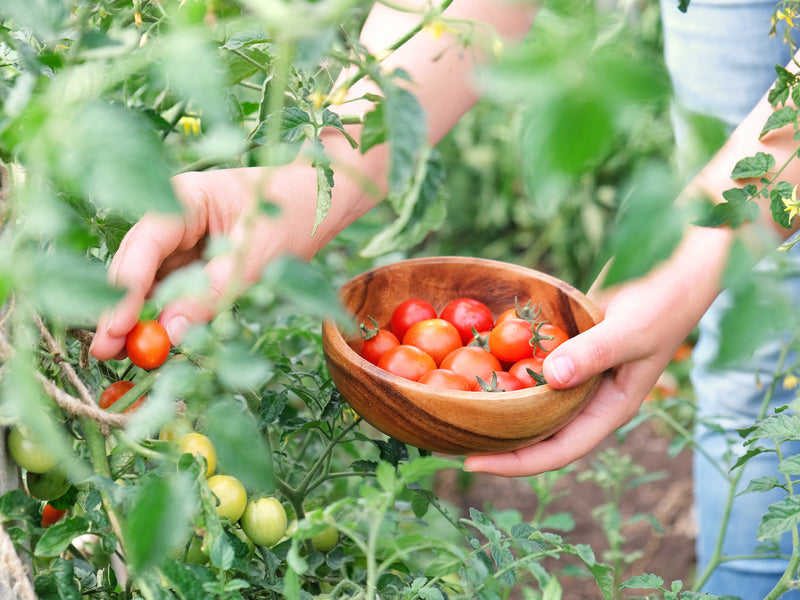Homegrown, vine-ripened tomatoes are more delicious than anything you can purchase in a grocery store. Here is our quick guide to growing tomatoes!
PLANTING
Start indoors using 4 inch pots. Sprinkle only 3 seeds over moist seed starting soil, then cover with 1/4” layer of soil (do not pack)
WATER
2-3 oz per watering, or less. Allow the top 1/2’ of soil to dry slightly between waterings. DO NOT over-water or white fuzz (fungus) will grow on pots and soil
AIR
Well-ventilated room, use a small fan to increase airflow
SUNLIGHT
6-8 hours per day of direct sunlight, or 12-16 hours per day grow lights
TEMPERATURE
60-85 degrees (70-80 degrees ideal for sprouting)
GERMINATION
7-14 days to see sprouts
THINING
Remove weaker seedlings when the strongest seedling is about 2 inches. Remove weaker seedlings by cutting them off at soil level with scissors being careful not to disturb the roots of the remaining seedling.
TRANSITIONING TO OUTDOORS
When seedling is 3-4” and outside temperatures are 60˚ or warmer, begin hardening off your tomato plant. Hardening off is the 1 week process of moving plants outdoors for part of each day to gradually introduce them to direct sunlight, dry or moist air, and cooler nights.
PLANTING LOCATION
Choose an outdoor location that receives 6-8 hours of direct sunlight. If planting into a container choose one that is 12"x12" or larger with good drainages.
PREPARING THE SOIL
If planting in a garden plot, read this article on how to prepare the soil.
If planting in a raised bed, read this article on how to prepare the soil.
FERTILIZING
No fertilizer needed until transplant. Then once every month lightly top dress soil with organic fertilizer and water in thoroughly. We recommend using our Organic Starter-Transplanter fertilizer at transplant and until the plant starts flowering, then using our Organic All-Purpose vegetable garden fertilizer during the rest of the growing season.
TRANSPLANTING
Best time of day to transplant is early in the morning, late in the afternoon or on a cloudy day.
Water seedling 2 hours before transplanting.
Dig a single hole several inches deeper than the size of your starting pot in your new outdoor location.
Gently remove seedling from its pot by squeezing the sides to help loosen and separate. Set tomato transplant into the prepared soil, burying the stem up to the bottom two sets of leaves.

OUTDOOR GROWING
Keep evenly watered to prevent fruit from cracking. This is especially important when growing in containers because the soil dries out quicker. Using mulch around the base of your tomato plant will help the soil hold moisture. Recommended mulches are organic straw for warm climates and compost for areas more prone to slugs. Note: Always water tomato plants at the base of the plant avoiding getting water on the leaves.
TOMATO SUPPORT
Most varieties of tomato bush require some sort of support to keep the fruit and leaves off the ground, reducing soil borne diseases. You can tie your tomatoes to a staking, use tomato cages or training tomatoes up trellises. Removing the lower leaves of the plant is also a good way to keep the leaves and fruit off the soil.
FRESH OFF THE VINE
Harvest when tomatoes are bright red and comes off the stem easily.
BRINGING TO HARVEST
These sun-loving plants cannot survive frost. If cool weather is approaching and your tomatoes have not fully ripened here are steps you can take.
Water less frequently. This makes the plant concentrate on ripening fruit rather than growing and creating more foliage.
Pick fully formed green fruit and let ripen indoors. Put green tomatoes in a paper bag and leave on the counter to ripen.
PRESERVING YOUR HARVEST
For best flavor, store ripe tomatoes at room temperature indoors (65°-70°). At room temperature tomatoes will keep for 4 to 7 days.
Tomatoes can be canned or dried but the easiest way to preserve tomatoes is freezing them. To freeze tomatoes, wash them, remove stems and then dry. Place tomatoes on a baking tray in the freezer. Once frozen, store tomatoes in freezer bags or airtight containers. Frozen tomatoes will stay good in the freezer for up to a year. Use them throughout the year in sauces, chilis and soups!














